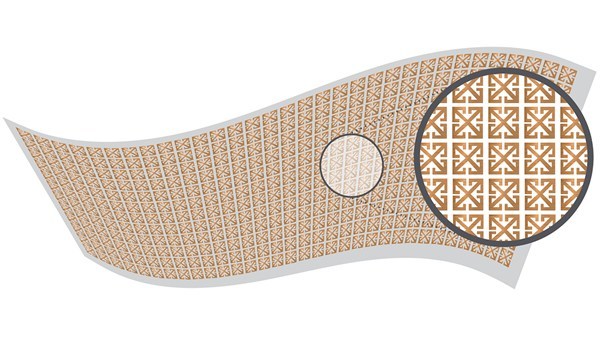Metamaterials

|
Contents |
[edit] Introduction
Metamaterials are composite media that can be engineered to exhibit properties that would not otherwise be naturally occurring in materials. The addition of the Greek prefix ‘meta’ (meaning beyond) implies that the substances exhibit properties that go beyond what would be typical.
Metamaterials are made up of nanoparticle building blocks (typically based on composite metals and plastics) that use extremely small, repetitive patterns to interact with light or other waves to produce dynamic effects. The refinement of the refraction can be modified to produce different values and transform positive refraction into negative.
[edit] Negative refraction
Negative refraction of light and other wave forms can be a highly desirable property. It bends waves as they enter the structure of the metamaterial, which may allow the materials to exhibit certain properties, including:
- Invisibility or optical camouflage.
- Extreme light magnification.
- Negative electrical permittivity and magnetic permeability.
[edit] Applications for metamaterials
Metamaterials capable of negative refraction may prove useful in the production of electronics, insulation and coating, heat transfer, energy harvesting and so on.
In the field of photovoltaics, some metamaterials can incorporate repetitive patterns to make better use of solar radiation. This could assist with the problem of silicon and other materials that demand certain cooling levels to maintain their efficiency. Their properties may enhance device light absorption while producing more electricity and improving efficiency through passive radiative cooling. .
Another such metamaterial is a type of sound control panel that uses acoustic metamaterials to make changes to audio waves. This type of product has the same noise reduction effect as conventional materials (such as plywood) but is significantly lighter. It bends sound waves to shape and control them.
[edit] Related articles on Designing Buildings
Featured articles and news
The UK's Modern Industrial Strategy: A 10 year plan
Previous consultation criticism, current key elements and general support with some persisting reservations.
Building Safety Regulator reforms
New roles, new staff and a new fast track service pave the way for a single construction regulator.
Architectural Technologist CPDs and Communications
CIAT CPD… and how you can do it!
Cooling centres and cool spaces
Managing extreme heat in cities by directing the public to places for heat stress relief and water sources.
Winter gardens: A brief history and warm variations
Extending the season with glass in different forms and terms.
Restoring Great Yarmouth's Winter Gardens
Transforming one of the least sustainable constructions imaginable.
Construction Skills Mission Board launch sector drive
Newly formed government and industry collaboration set strategy for recruiting an additional 100,000 construction workers a year.
New Architects Code comes into effect in September 2025
ARB Architects Code of Conduct and Practice available with ongoing consultation regarding guidance.
Welsh Skills Body (Medr) launches ambitious plan
The new skills body brings together funding and regulation of tertiary education and research for the devolved nation.
Paul Gandy FCIOB announced as next CIOB President
Former Tilbury Douglas CEO takes helm.
UK Infrastructure: A 10 Year Strategy. In brief with reactions
With the National Infrastructure and Service Transformation Authority (NISTA).
Ebenezer Howard: inventor of the garden city. Book review.
The Grenfell Tower fire, eight years on
A time to pause and reflect as Dubai tower block fire reported just before anniversary.
Airtightness Topic Guide BSRIA TG 27/2025
Explaining the basics of airtightness, what it is, why it's important, when it's required and how it's carried out.
Construction contract awards hit lowest point of 2025
Plummeting for second consecutive month, intensifying concerns for housing and infrastructure goals.
Understanding Mental Health in the Built Environment 2025
Examining the state of mental health in construction, shedding light on levels of stress, anxiety and depression.





















